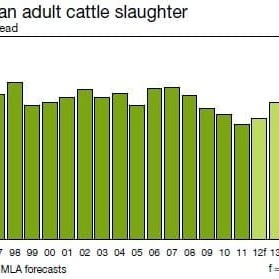The 2012 beef slaughter season is ending with a bang, rather than a whimper, with the year’s second highest weekly kill recorded last week, as processors head towards their Christmas break.
The National Livestock Reporting Service yesterday logged an Eastern States kill for the seven days ended Friday of 145,227 head, down just 0.3 percent or 400 head from the previous week’s year-high record. Last week’s tally was a full 6pc above this time last year.
The result was strongly influenced by the continuation of very dry seasonal conditions across large areas of southern Queensland and NSW, with producers offloading surplus stock before most northern plants commence their seasonal holiday closure.
Queensland last week recorded a mild 3pc decline in activity, down to 74,476 head, partly due to early closures of large plants like Teys Australia Biloela.
This current week’s Queensland tally can be expected to drop away dramatically, as many export sheds will carry out their last slaughter shift for the year tomorrow or Thursday, with last boning and load-out shifts before the weekend.
Two or three week closures will then follow for many of Queensland’s larger export processing plants, with most expected to recommence operations the week starting Monday, January 7, January 14 or in a few cases, January 21.
That’s subject to rain, of course, and any big monsoonal weather system impacting Queensland and northern NSW could delay seasonal starts further, as they have in the past.
Part of the explanation behind last week’s big throughput is the desire to stockpile some product in storage before the seasonal closures occur. Larger, multi-site operators with factories in southern Australia tend to rely, also, on southern processing operations to see them through the holiday period.
To put last week’s Eastern kill performance into perspective, it was only the sixth time this year that processing throughputs have exceeded 140,000 head, and four of those have come since mid-November.
Southern states all strengthened their tallies last week, reaching seasonal turnoff high-points in many cases.
New South Wales numbers rose another 1pc to reach 34,566 head. In Victoria, processors jumped a further 4pc to 22,950 head, while those in South Australia lifted 2pc to 8634 head, and Tasmania, +6pc to 4601 head.
Given that this is Beef Central’s final weekly kill report for 2012, it is worth reflecting briefly on the season as a whole, and the prospects that lie ahead.
As forecast by MLA during its mid-year update in July, rates of slaughter have lifted during the second half of the year, after an erratic period from January-June impacted by adverse weather conditions hampering cattle access logistics, and sluggish to inconsistent export markets impacting on demand.
As can be seen in Beef Central’s home-page weekly kill graph, much of the volatility disappeared during the second half of the year, with a fairly consistent increase in numbers across the half-year.
What’s in store for 2013?
 The final 2012 national calendar year adult beef slaughter tally looks like going close to MLA’s mid-year forecast of 7.4 million head. While that would represent a rise of almost 2 percent on last year (7.261m), the result should be put into some context.
The final 2012 national calendar year adult beef slaughter tally looks like going close to MLA’s mid-year forecast of 7.4 million head. While that would represent a rise of almost 2 percent on last year (7.261m), the result should be put into some context.
It should be remembered that 2011 was one of the smallest annual kills in recent history, due to widespread female retention and herd rebuilding after two consecutive good seasons, and a flood/rain-plagued start to the year.
The 2010 season tally, in comparison, was 2.8pc larger than 2011 at 7.473m, as the effects of drought across northern Australia saw large-scale liquidation. As can be seen in the adult kill graph published here, the years before that – 2007-2009 – were even bigger kills, hitting 7.9m, 7.9m and 7.6m respectively.
The graph also clearly shows the forecast rise in kills which started modestly this year, and which is likely to gather pace out to 2016, due to the effects of recent seasons and herd rebuilding.
At this point, MLA is forecasting adult cattle kill next year to reach 7.7 million head – a 4pc rise on this year. Part of that will be a response from ‘early’ increase in calf numbers born since improved seasons started, and partly due to older cows that will be repatriated after squeezing-out an extra calf or two beyond their normal ‘use-by’ date.
From there-on, however, the growth in rates of slaughter, assuming average to good seasonal conditions, is predicted to explode, reaching 8.025m head in 2014, 8.25m in 2015 and an all-time record 8.4m head in 2016. That’s about one million head above where it sits today.
One of the truly dark clouds on the industry’s horizon for 2013 is currency value. One large processor told beef Central yesterday that its banker was forecasting an A$ value at, or above US110c during early stages of 2013. A sobering prospect, by any measure, in an increasingly competitive international marketplace. We can only hope such a forecast does not come to pass.
- Beef Central’s first weekly kill report for 2013 will appear in the week commencing January 7.
